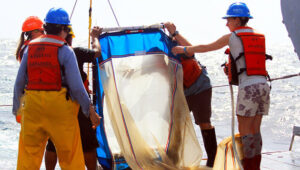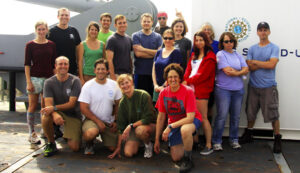2014 Chief Scientist Training Cruise – The Story Behind the Science

Earlier this month, the 2014 University-National Oceanographic Laboratory System (UNOLS) Chief Scientist Training Cruise wrapped up, with the R/V Atlantic Explorer returning to her berth at BIOS after a nine day cruise between Barbados and Bermuda. The purpose of these cruises is to give early-career marine scientists, including PhD students, insight into what it takes to successfully plan and execute a research cruise—everything from acquiring funded ship time to mobilizing laboratory equipment and supplies, from reporting at sea to living aboard a working research vessel.
This year, with funding from the National Science Foundation, the cruise participants were able to blog about their time at sea, sharing information with students and the general public about their individual research projects during the cruise. The blog (http://csw.unols.org) even gave people a chance to ask scientists questions along the way! By the time the cruise was over in early July, a dozen K-12 schools and universities had signed up to participate in the blog, with students signing in from Nova Scotia (Dalhousie University) to Connecticut (Amity High School) to New York (The Young Women’s Leadership School of East Harlem).
Steve Tuorto, Postdoctoral Researcher at Rutgers University, created and managed the blog in addition to conducting his own research during the cruise studying the microbes in the ocean and how they interact. “This program, cruise, and the blog was one of the more worthwhile things I’ve ever done,” he said. “As for the blog,” he continued, “I created and implemented it, but it was the willingness of the science party to contribute that made it work so well. We had no idea we would have such a large number of comments and questions, let alone such specific and engaged interaction. As you can tell from the posts, everyone embraced it.”
From the perspective of an early career scientist, Steve added, “This was my first cruise, as most of my work to date has focused on coastal and terrestrial environments. I had zero experience with how to do most steps involved in pre & post cruise activities. I learned the basis for everything I need, either at sea or as part of the workshop—this was the ideal experience!”

The team on board the R/V Atlantic Explorer. Photo by Paul Suprenand.
Dr. Maureen Conte, Associate Scientist at BIOS, was the cruise mentor responsible for providing hands-on training in the skills needed to become an effective seagoing scientist, as well as assisting participants before, during, and after the cruise. As a biochemist and Principal Investigator for the Oceanic Flux Program, Dr. Conte has been aboard many research cruises to measure the quantity and composition of particles sinking through the deep Sargasso Sea.
When asked about the cruise, Dr. Conte remarked, “The experience was so productive and a lot of fun. Participants went home with valuable samples and with the knowledge about how to propose, plan, organize, and execute their own research cruise in the future. The Atlantic Explorer crew did a super job teaching the group about their roles in support of science activities on a research ship.”
Although the blog is now closed, you can still view the blog posts and “Meet the Scientist” profiles, as well as the numerous questions and answers that were posted along the way. We encourage anyone interested in a career in marine science or oceanography to take a look at the blog, not only for the fascinating stories and posts, but also for some incredible photography from Paul Suprenand, Postdoctoral Researcher at the University of South Florida and one of the cruise’s Co-Chief Scientists.
